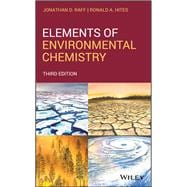A practical approach to environmental chemistry, Elements of Environmental Chemistry, 3rd Edition provides readers with the fundamentals of environmental chemistry and a toolbox for putting them into practice. This is a concise, accessible, and hands-on volume designed for students and professionals working in the chemical and environmental sciences.
The 3rd Edition has been completely revised and rearranged. The first chapter on tool skills has been expanded to include thermodynamic considerations and measurement issues. The former chapter on the partitioning of organic compounds has been expanded to cover the fates of organic compounds, with an emphasis on developing the readers chemical intuition for predicting a chemicals fate based on structure. The material on lead, mercury, pesticides, PCBs, dioxins, and flame retardants has been expanded and combined into the last chapter and supplemented with more references to the literature. The problem sets have been extended and now include over 130 problems, some of which can be solved using Excel.








